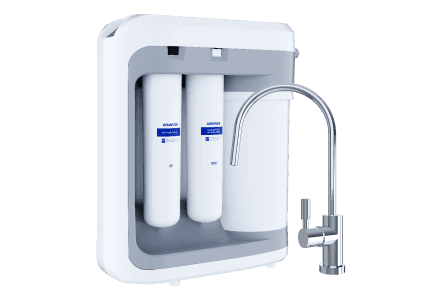- Price
- Clear All
Advantages of reverse osmosis systems
Reverse osmosis is a technology used by bottled water and food manufacturers around the world. Home reverse osmosis filters (membrane water purifiers) make tap water of any quality absolutely safe.
It’s much more budget-friendly to install a reverse osmosis water purification system right in the kitchen under the sink than to buy bottled water. The cost of water you get at home is at least 10 times less.
How does reverse osmosis work?
Due to the pipeline pressure, water is pressed through the reverse osmosis membrane. It does not let any other substances through except water, therefore harmful impurities and hardness salts remain on its surface, and then are washed off into the sewer (drain water). Reverse osmosis is based on the natural biological process called osmosis: it helps to saturate the cells of plants, animals and humans with useful substances (water carries them through the cell membrane).
What are the characteristics of the reverse osmosis filtered water?
RO filter makes water safe, eliminating any contaminants. It even removes pesticides, nitrates, hormones, antibiotics, bacteria and viruses. Hospitals and dialysis stations use reverse osmosis systems to remove the most difficult-to-separate impurities (their trace amounts can be dangerous). Because of its utter safety, water purified by reverse osmosis filters is best suited for the baby food.
Why is reverse osmosis used for protection against scale?
The membrane in a reverse osmosis system does not let any hardness salts (calcium and magnesium, which are the main reason of scale formation and equipment breakdown) through. Therefore, reverse osmosis is the most effective means of hard water purification. Compare: in sorption filters, softening cartridges need to be changed every 1-2 months, and in reverse osmosis systems, you get rid of scale for the entire membrane life period (1.5-2 years).

